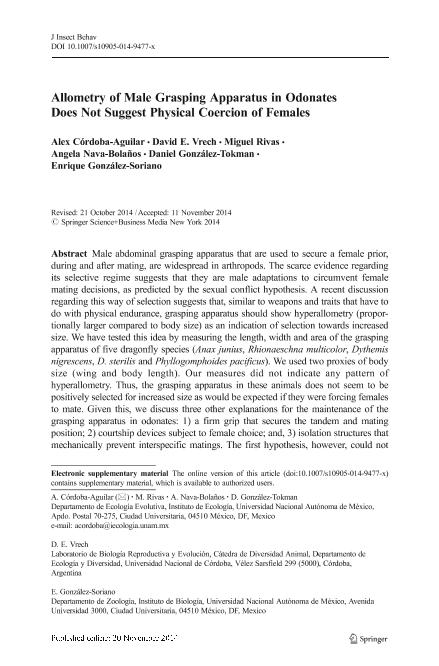Mostrar el registro sencillo del ítem
dc.contributor.author
Córdoba Aguilar, Alex
dc.contributor.author
Vrech, David Eduardo

dc.contributor.author
Rivas, Miguel
dc.contributor.author
Nava Bolaños, Angela
dc.contributor.author
González Tokman, Daniel
dc.contributor.author
González Soriano, Enrique
dc.date.available
2023-01-25T21:02:58Z
dc.date.issued
2015-01
dc.identifier.citation
Córdoba Aguilar, Alex; Vrech, David Eduardo; Rivas, Miguel; Nava Bolaños, Angela; González Tokman, Daniel; et al.; Allometry of Male Grasping Apparatus in Odonates Does Not Suggest Physical Coercion of Females; Springer/Plenum Publishers; Journal of Insect Behavior; 28; 1; 1-2015; 15-25
dc.identifier.issn
0892-7553
dc.identifier.uri
http://hdl.handle.net/11336/185628
dc.description.abstract
Male abdominal grasping apparatus that are used to secure a female prior, during and after mating, are widespread in arthropods. The scarce evidence regarding its selective regime suggests that they are male adaptations to circumvent female mating decisions, as predicted by the sexual conflict hypothesis. A recent discussion regarding this way of selection suggests that, similar to weapons and traits that have to do with physical endurance, grasping apparatus should show hyperallometry (proportionally larger compared to body size) as an indication of selection towards increased size. We have tested this idea by measuring the length, width and area of the grasping apparatus of five dragonfly species (Anax junius, Rhionaeschna multicolor, Dythemis nigrescens, D. sterilis and Phyllogomphoides pacificus). We used two proxies of body size (wing and body length). Our measures did not indicate any pattern of hyperallometry. Thus, the grasping apparatus in these animals does not seem to be positively selected for increased size as would be expected if they were forcing females to mate. Given this, we discuss three other explanations for the maintenance of the grasping apparatus in odonates: 1) a firm grip that secures the tandem and mating position; 2) courtship devices subject to female choice; and, 3) isolation structures that mechanically prevent interspecific matings. The first hypothesis, however, could not explain the highly elaborated and species specific morphology of grasping apparatus in these animals. Support for the second hypothesis comes from the fact that odonate females have mechanoreceptor sensilla embedded in their mesostigmal plates (the place grabbed by the grasping apparatus). For the third hypothesis, coevolutionary patterns in morphology in the grasping apparatus and mesostigmal plates in some Zygoptera can also be used as support.
dc.format
application/pdf
dc.language.iso
eng
dc.publisher
Springer/Plenum Publishers

dc.rights
info:eu-repo/semantics/openAccess
dc.rights.uri
https://creativecommons.org/licenses/by-nc-sa/2.5/ar/
dc.subject
ALLOMETRY
dc.subject
COERCION
dc.subject
LOCK AND KEY
dc.subject
MALE GRASPING APPARATUS
dc.subject
ODONATA
dc.subject
STIMULATION
dc.subject.classification
Biología Reproductiva

dc.subject.classification
Ciencias Biológicas

dc.subject.classification
CIENCIAS NATURALES Y EXACTAS

dc.title
Allometry of Male Grasping Apparatus in Odonates Does Not Suggest Physical Coercion of Females
dc.type
info:eu-repo/semantics/article
dc.type
info:ar-repo/semantics/artículo
dc.type
info:eu-repo/semantics/publishedVersion
dc.date.updated
2023-01-23T16:38:40Z
dc.identifier.eissn
1572-8889
dc.journal.volume
28
dc.journal.number
1
dc.journal.pagination
15-25
dc.journal.pais
Estados Unidos

dc.journal.ciudad
New York
dc.description.fil
Fil: Córdoba Aguilar, Alex. Universidad Nacional Autonoma de Mexico. Instituto de Ecologia. Departamento de Ecologia Funcional; México
dc.description.fil
Fil: Vrech, David Eduardo. Consejo Nacional de Investigaciones Científicas y Técnicas. Centro Científico Tecnológico Conicet - Córdoba. Instituto de Diversidad y Ecología Animal. Universidad Nacional de Córdoba. Facultad de Ciencias Exactas Físicas y Naturales. Instituto de Diversidad y Ecología Animal; Argentina
dc.description.fil
Fil: Rivas, Miguel. Universidad Nacional Autonoma de Mexico. Instituto de Ecologia. Departamento de Ecologia Funcional; México
dc.description.fil
Fil: Nava Bolaños, Angela. Universidad Nacional Autonoma de Mexico. Instituto de Ecologia. Departamento de Ecologia Funcional; México
dc.description.fil
Fil: González Tokman, Daniel. Universidad Nacional Autonoma de Mexico. Instituto de Ecologia. Departamento de Ecologia Funcional; México
dc.description.fil
Fil: González Soriano, Enrique. Universidad Nacional Autonoma de Mexico. Instituto de Biologia. Departamento de Zoología.; México
dc.journal.title
Journal of Insect Behavior

dc.relation.alternativeid
info:eu-repo/semantics/altIdentifier/url/https://link.springer.com/article/10.1007/s10905-014-9477-x#Abs1
dc.relation.alternativeid
info:eu-repo/semantics/altIdentifier/doi/https://doi.org/10.1007/s10905-014-9477-x
Archivos asociados
